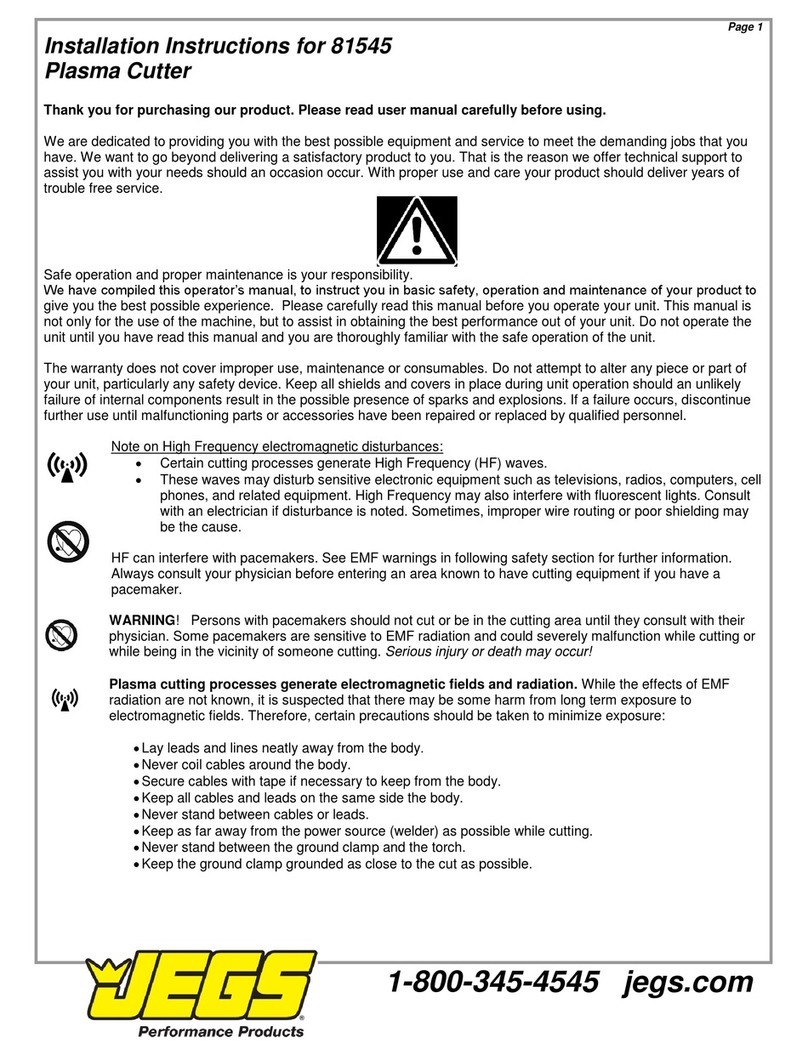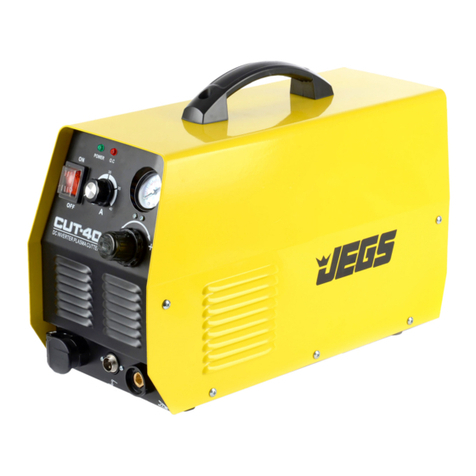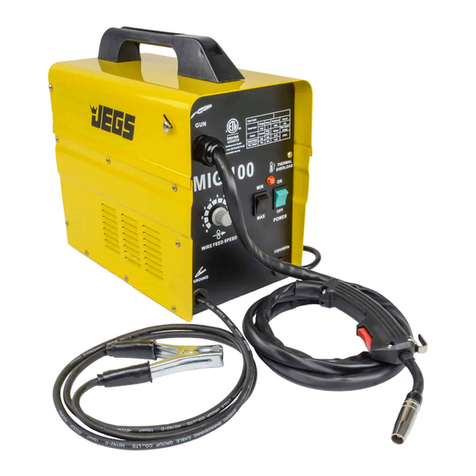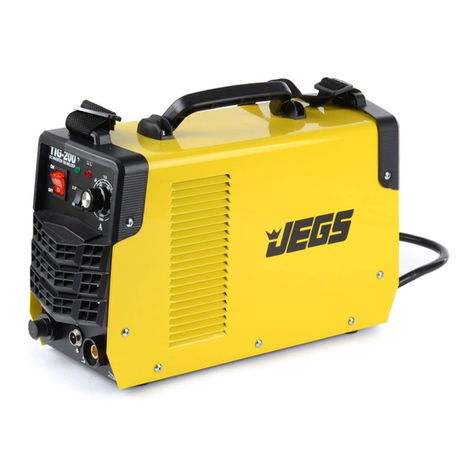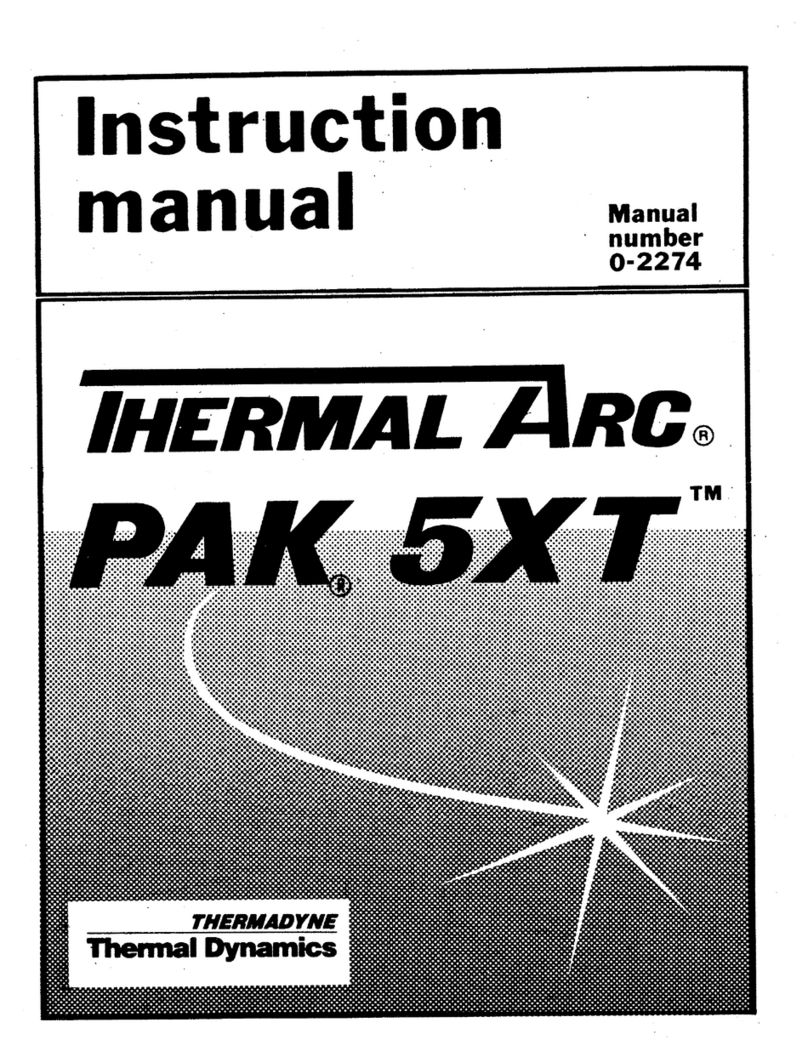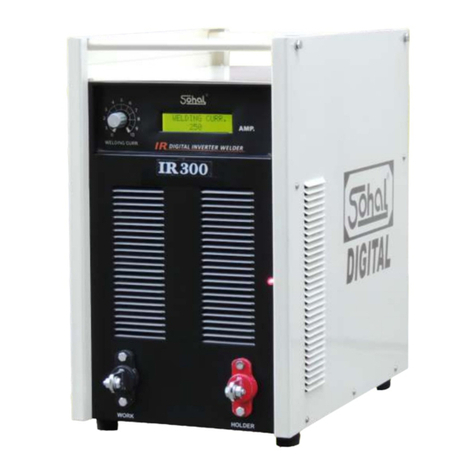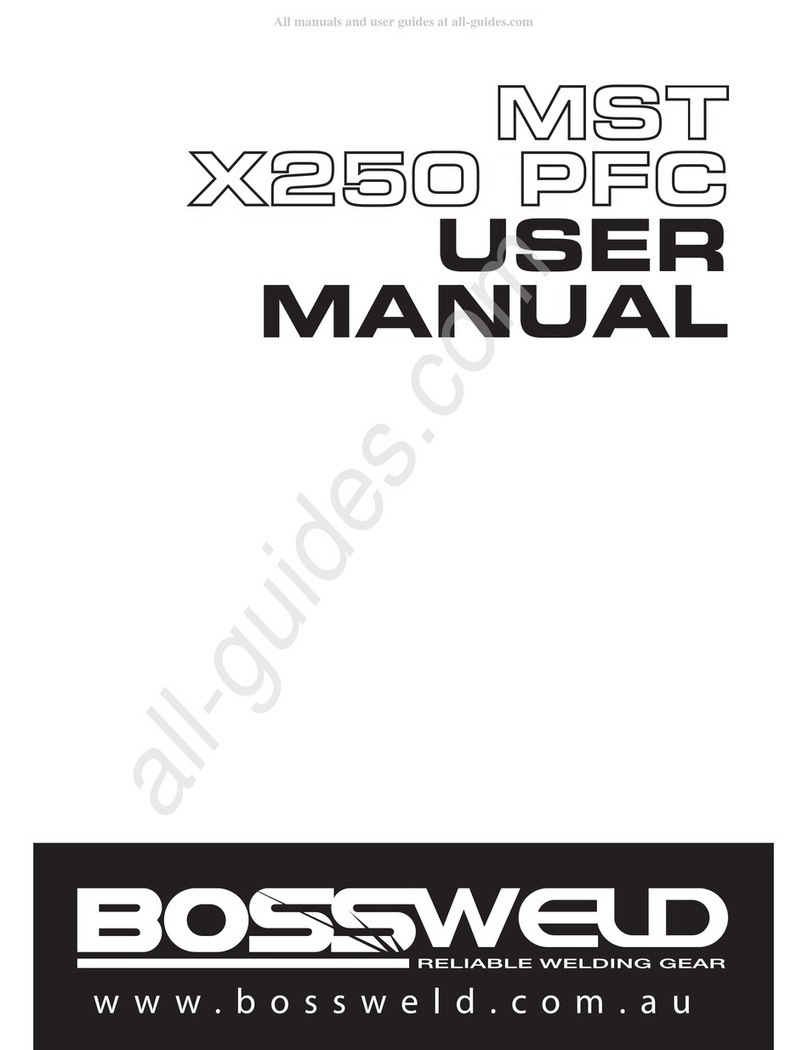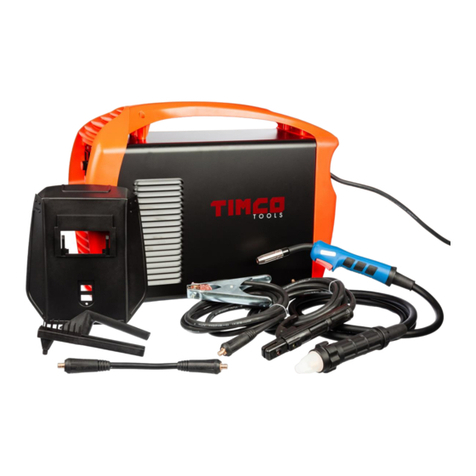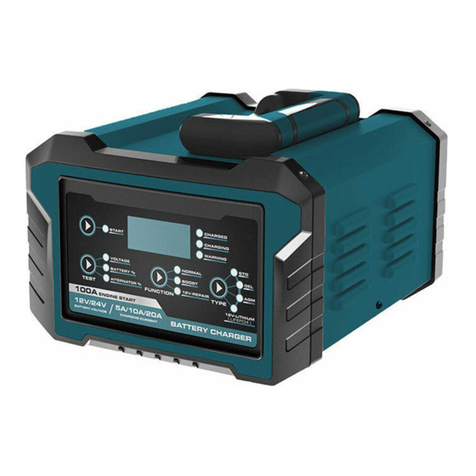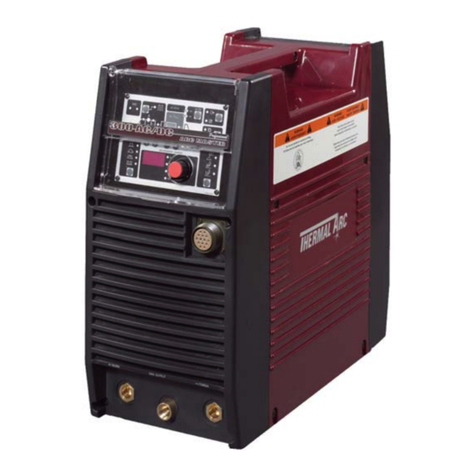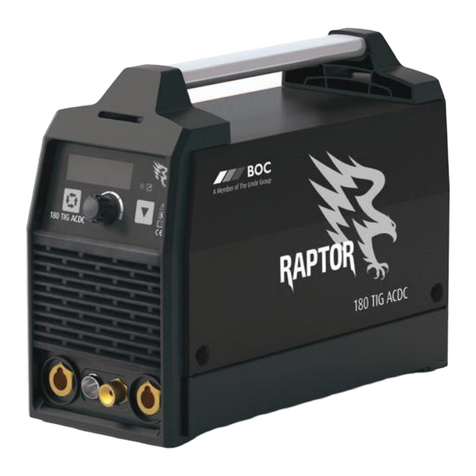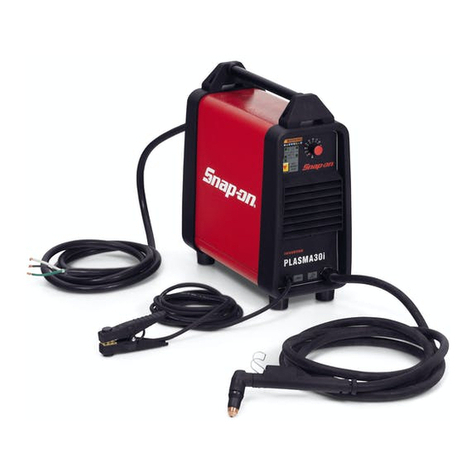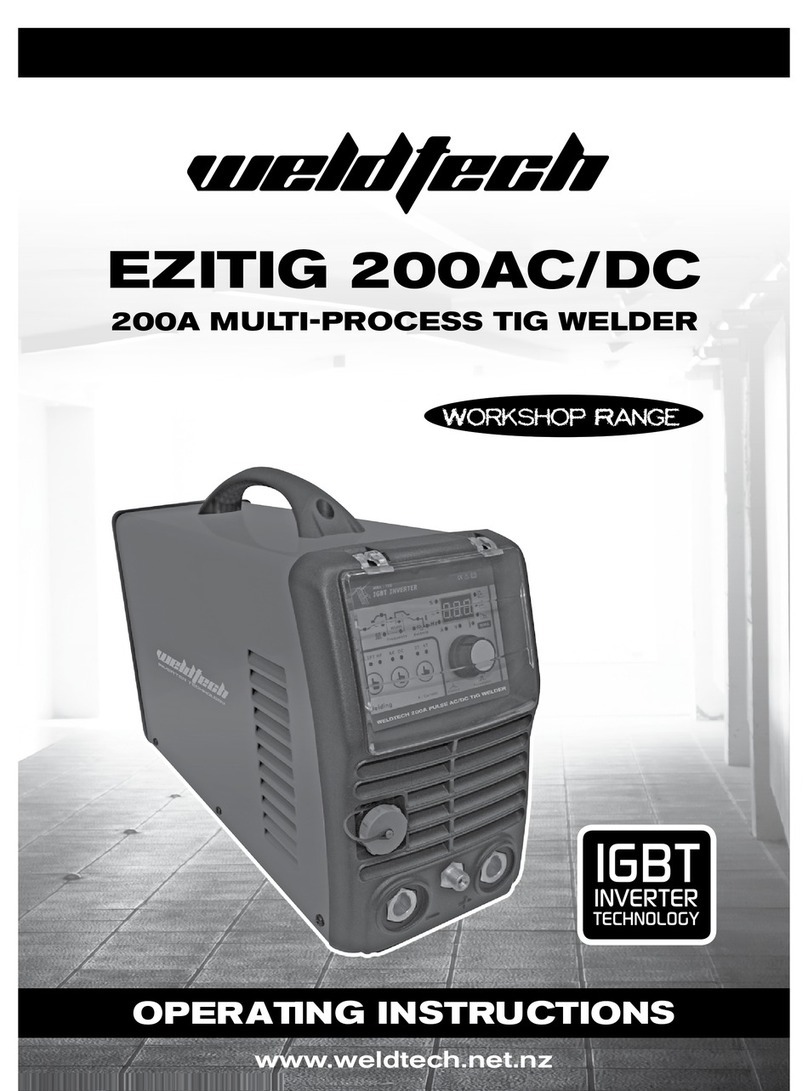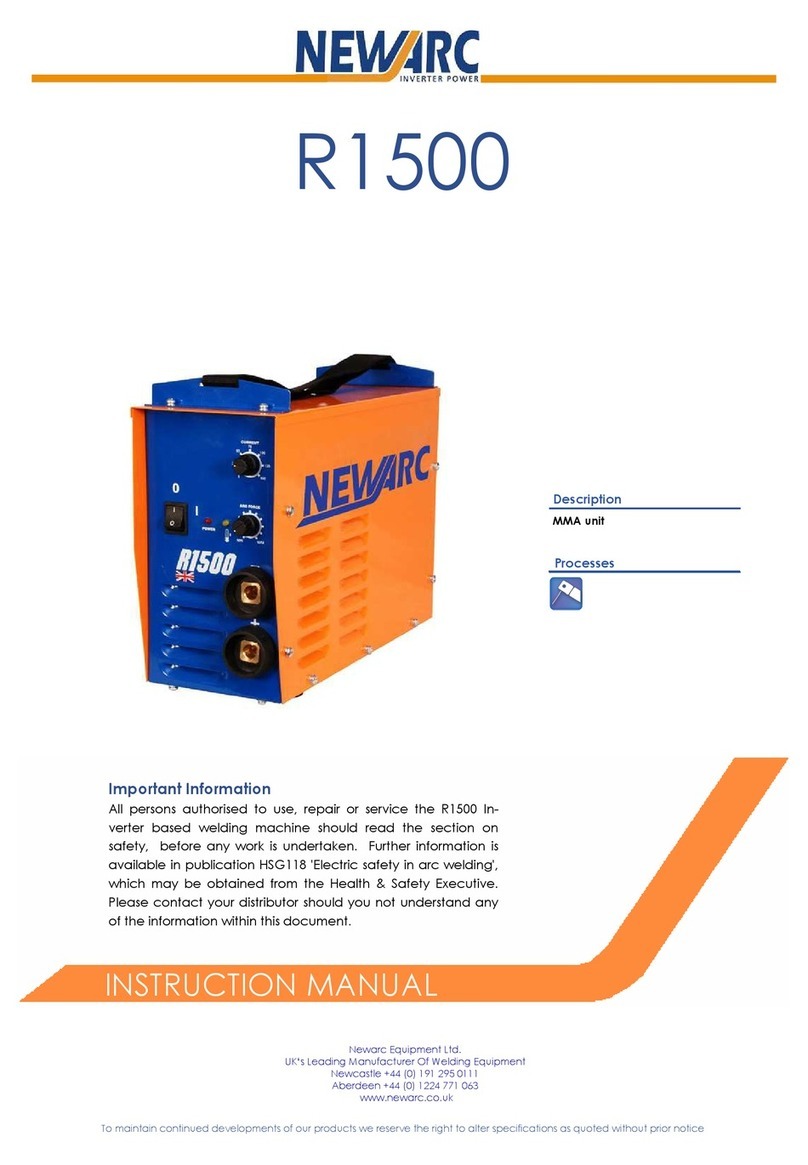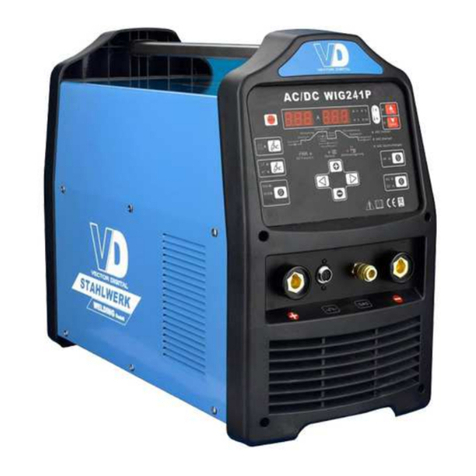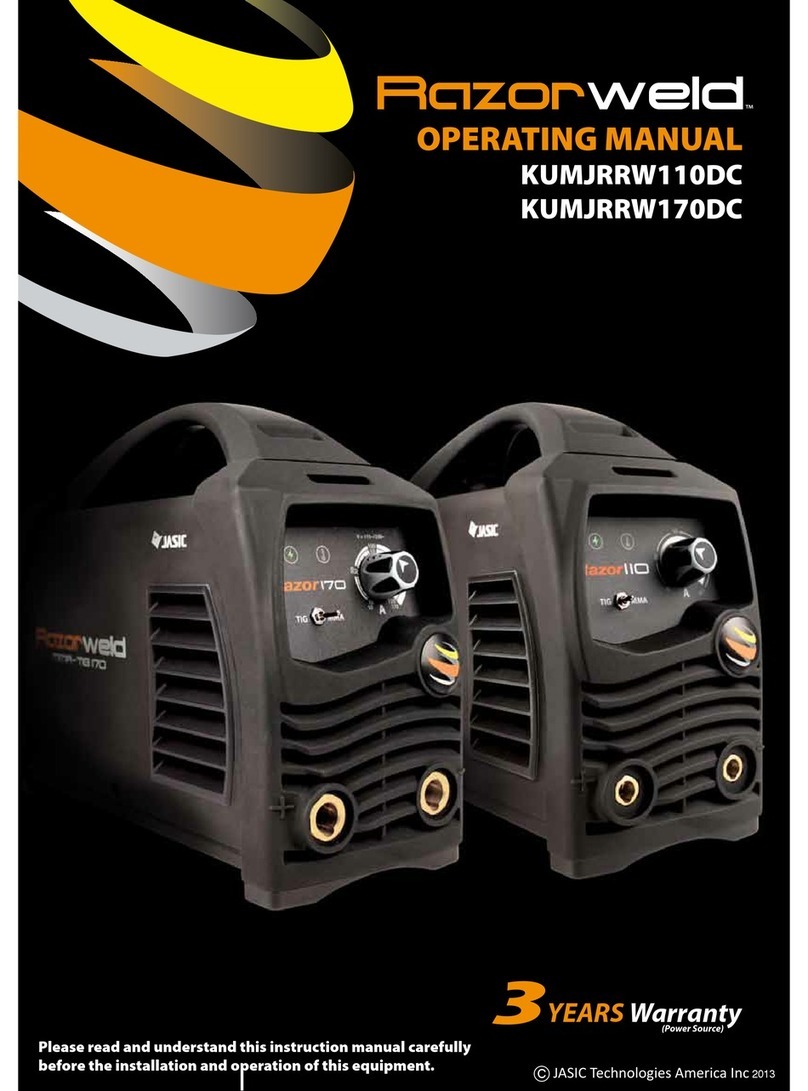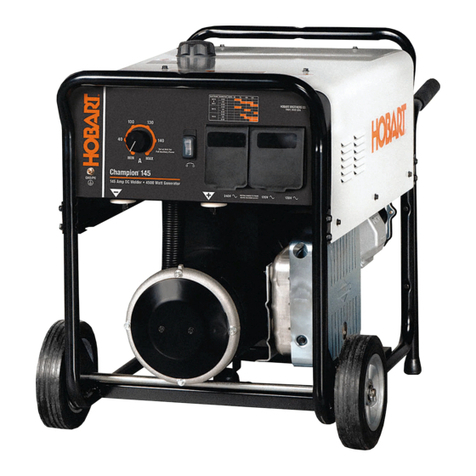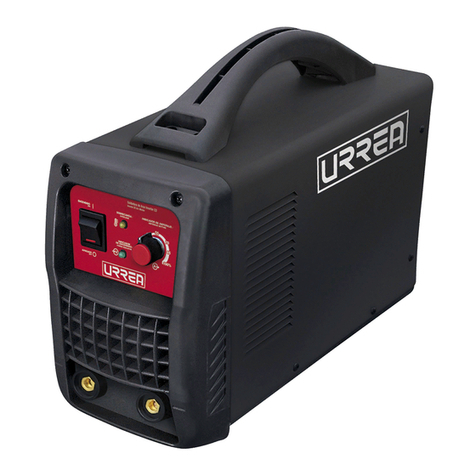Jegs IGBT Series User manual

OWNER'S MANUAL
THE IGBT SERIES OF MIG/MAG

1
CONTENTS
‐1.Safety……………………..………………..…………………………….…..……....……………………………………………………. 2
‐2.General Description……...………......……...…………………….………...……….....……………………………………….. 4
‐3.Main Parameter…….……...…...........…….....………………………………….…..……….…………………………………… 6
‐4.Structure of welder…….……...…...........………………………..…………….…..……….…………………………………… 7
‐5.Installation ……………………………………………………………………………………………………………………………….. 8
‐6.Welding settings quick reference chart………………………………………………………………………………………. 15
‐7.Range of welding current and voltage in CO2 welding...……….…………………………………………………… 20
‐8.Welding parameters table.......…....................……………………….………..…………………………………………… 20
‐9.Caution……….....................…………………………………………...………………. .....…...................................... 22
‐10. Maintenance….………………………………………….……………….….……....….…………………………………………… 23
‐11. Daily checking……………………………………….….……....….………………………………………….…………………….. 24
‐12. Connection diagram of the machine………………………………….….……....….………………………………….. 27
‐13. Explosion drawing…………………………..………………………………….….……....….………………………………….. 28

2
This welding machine for industrial and professional use is in conformity with IEC974 International
Safety Standard.
Hereby we state that we provide one year of guarantee for this welding machine since the date of
purchase.
Please read and understand this instruction manual carefully before the installation and operation
of this machine.
The contents of this manual may be revised without prior notice.
This instruction manual is issued in January 2021.
1.SAFETY
Welding and cutting is dangerous to the operator, people in or near the working area, and the surrounding
area if the machine is not correctly operated. Therefore, the performance of welding/cutting must only be
under the strict and comprehensive observance of all relevant safety regulations. Please read and
understand this instruction manual carefully before the installation and operation.

3
∙The switching of function modes while the welding operation is performed, may
damage the machine.
∙Disconnect the electrode‐holder cable with the machine, before turning
machine on.
∙A safety switch is necessary to prevent the machine from electrical leakage.
∙Welding tools used should be of high quality.
∙Operators should be qualified.
Electric shock: It could be fatal!
∙Connect the earth cable according to standard regulation.
∙Avoid all contact with live electrical parts of the welding circuit, electrodes and
wires with bare hands. It is necessary for the operator to wear dry welding
gloves while he/she performs the welding task.
∙The operator should keep the working piece insulated from himself/herself.
Smoke and gas generated while welding or cutting is harmful to people’s
health.
∙Avoid breathing the smoke and gas generated while welding or cutting.
∙Keep the working area well ventilated.
Arc rays: harmful to people’s eyes and skin.
∙Wear welding helmet, anti‐radiation glass and work clothes while the welding
operation is performed.
∙Measures also should be taken to protect people in or near the working area.
.
Fire hazard
∙The welding spatter may cause fire, thus remove flammable material away from
the working place.
∙Have a fire extinguisher nearby, and have a trained person ready to use it.
Noise: possibly harmful to peoples’ hearing.
∙Noise is generated while welding/cutting, wear approved ear protection if noise
level is high.
Machine fault:
∙Consult this instruction manual.
∙Contact your local dealer or supplier for further advice.

4
2.GENERAL DESCRIPTION
This welding machine is composed of the inverter MIG welder power supply with invariable voltage output
external characteristics manufactured with advanced IGBT inverter technology.
With high‐power component IGBT, the inverter converts the DC voltage, which is rectified from input
50Hz/60Hz AC voltage, to high‐frequency 20KHz AC voltage; as a consequence, the voltage is transformed
and rectified. The features of this machine are as follows:
●IGBT inverter technology, current control, high quality, stable performance;
●Closed feedback circuit, invariable voltage output, great ability of balance voltage up to ±15%;
●Electron reactor control, stable welding, little splash, deep molten pool, excellent welding bead shaping;
●Welding voltage can be preset, and the voltmeter displays the preset voltage value when not welding.
●Both welding current and welding voltage can be observed at the same time.
●Burn back time is adjustable.
●Slow wire feeding during arc starting, remove the melting ball after welding,reliable arc starting;
●Wire feeding part is separated from the welding machine, wide welding operation range.
●Small‐sized, light‐weighed, easy to operate, and economical.
Unpacking your machine
When unpacking, inspect carefully for any damage that may have occurred during transit.
Check carefully to ensure all the contents on the list below have teen received in good condition
Included items:
No. Description Qty. Pic
1MIGWelder 1pc
2 Operator’s Manual 1pc
3 Electrode Holder 4m 1pc
4EarthClamp4m 1pc
53mMIGtorch 1pc
6Tigtorch 1pc
7Regulator 1pc
8GasHose4m 1pc
9 115/230V Adapter 1pc

5
10 Roller 0.8mm‐0.9mm
Operating environment
Adequate ventilation is required to provide proper cooling for the MIG‐GS/GD. Ensure that the machine
is placed on a stable level surface where clean cool air can easily flow through the unit. The
MIG‐GS/GD has electrical components and control circuit boards which will be damaged by
excessive dust and dirt, so a clean operating environment is essential
Block Diagram
LIFT TIG also called the contact type arcing TIG.
Needed items: inverter welder with LIFT TIG function, contact type TIG torch with one output power cable and one air
tube.
The use way of LIFT TIG is shown as below:
The output power cable connect with the negative output terminal, and the air tube connect with the gas meter on the
argon gas bottle. There is a nut cover on the air tube, which can connect with the gas meter. The thread specification for
the gas meter and the nut should be the same. Then open the valve of the argon gas bottle and open the valve of the gas
meter, we can control the gas flow by adjusting the gas regulating valve on the TIG gun. Make the tungsten needle touch
the workpiece, lift the TIG gun up by little, then we can see the arcing.
INPUT
CONTROL

6
3.MAIN PARAMETER
Note : The welding duty cycle is the percentage of actual continuous welding time that can occur in a ten minute
cycle. For example: 15% at 200amps‐this means the welder can weld continuously at 200 amps for 1.5 minutes and
then the unit will need to be rested for 8.5 minutes.
The duty cycle can be affected by the environment in which the welder is used. In areas with temperatures exceeding
40℃, the duty cycle will be less than stated. In areas less than 40 ℃, higher duty cycles have been obtained
All tests on duty cycles have been carried out at 40℃with a 50%. So in practical working conditions the duty cycles will be
much greater than those stated above.
TYPE BLUEARC‐200MSTI
Power supply voltage (V) single‐phase
220V15%
Input current (A) 36
Power supply capacity (KVA) 8
Current adjustment range (A) 50~200
Output voltage (V) 15~24
Rated output current (A) 200
Rated out
p
ut volta
g
e
(
V
)
24
Rated dut
y
c
y
cle
(%)
30
Power factor 0.75
Efficiency (%) 85
Wire feeder t
yp
eExternal
/
Internal
Post‐flow time (s) 1
Welding wire diameter (mm) 0.6/0.8/1.0
Machine size (mm) 480×310×430
Machine weight (kg) 17
Plate thickness (mm) ≥0.8
Insulation class F
Protection class IP21S

7
4.Structure of welder
1. Left knob / welding mode selection knob/MIG
voltage refine
2. Left button/ home button
3. Right knob /Parameter adjust knob
4. Right button / Parameter adjust button /wire
speed/diameter/inductance/2T/4T/HOT
START/ARC FORCE
5. MIG Torch ‘Euro Style’ Connection Socket
6. Positive (+) Welding Output Terminal
7. Negative (‐) Welding Output Terminal
8. Polar conversion line
9. rating label
10. power switch
11. welding gas inlet
12. power cable
13. Wire tension adjustment
14. Wire tension arm & support roller
15. Wire input guide
16. Wire drive roller
17. Drive roller retainer
18. wire spool retainer
19. Spool brake adjustment
13
14
15 16
17
18
19
4
1
2
3
4
5
6
7
8
10
11
12
9

8
5.INSTALLTION
5.1. MIG Welding Set Up & Operation
5.1.1 Fitting the spool
5.1.1.1 open the cover door for the wire feed compartment. Remove the wire spool retainer(18) by threading off anti
clockwise.
5.1.1.2 fit the 200mm diameter wire spool to the spool holder, ensuring the end of the wires exits towards the wire
feeder from the bottom of the spool. Refit the wire spool retainer(18) and tighten finger tight.
5.1.1.3 set the spool brake tension by rotating the adjustment screw(19) using an allen wrench. Clockwise to increase
brake tension, counter‐clockwise to decrease brake tension. The spool brake tension should be set so that the spool can
rotate freely, but does not continue to rotate once the wire feed stops. This may need to be adjusted as the wire is used
up and the spool weight decreases.
5.1.2 Loading wire feeder
5.1.2.1 release the wire feeder tension arm(14) by pivoting the wire feed tension adjuster(13) as pictured below
20
21
22
23
24
25 26 27
20. Torch trigger switch
21. Torch “Euro” connector
22. Workpiece earth clamp
23. Earth lead quick connector
24. Conical gas nozzle/shroud
25. Welding tip
26. Shroud spring
27. Tip adapter

9
5.1.2.2 check the wire drive roller(16) groove matches the selected MIG wire type and size. The drive roller will have two
different sized grooves, the size of the groove in use is stamped on the side of the drive roller. For flux cored ‘soft’
wire ,such as that used in gasless MIG welding, the drive roller groove has a serrated profit. For solid ‘hard’ MIG wire, the
roller groove has a ‘v’ shaped profile
5.1.2.3 the drive roller(16) is removed by threading the drive roller retainer(17) off in the anti‐clockwise direction. Once
the correct drive roller profile is selected, re‐fit the drive roller.
5.1.2.4 thread the MIG wire from the spool through the input guide tube(15), through the roller groove and into the
outlet guide tube
5.1.2.5 Replace the tension arm (14) and the tension adjustment (13). Double check the wire has located correctly in
the drive roller groove.
5.1.2.6 Adjusting wire feed tension: this is accomplished by winding the knob on the wire tension adjustment arm (14).
Clockwise will increase tension, anti‐clockwise will decrease tension. There is a numbered scale on the tensioner to
indicate the position. Ideal tension should be as little as possible, while maintaining a consistent wire feed with no drive
roller slippage. Check all other possible causes of slippage, such as; incorrect/ worn drive roller, worn/ damaged torch
consumables, blocked/ damaged torch feed liner, before increasing feed tension.
Warning! ‐Before changing the feed roller or wire spool, ensure that the mains power is switched off
Warning! ‐The use of excessive feed tension will cause rapid and premature wear of the drive roller, the support
bearing and the drive motor.
5.1.3 setup for gasless MIG welding operation
5.1.3.1 Connect the MIG Torch Euro Connector (21) to the torch socket on the front of the welder (5). Secure by firmly
hand tightening the threaded collar on the MIG Torch Euro Connector clockwise.
5.1.3.2 Check that the correct flux cored, gasless wire, matching drive roller (16) and welding tip (25) are fitted
5.1.3.3 Connect Torch Connection Power Lead (8) to the negative (‐) welding output terminal (7).
5.1.3.4 Connect Earth Lead Quick Connector (24) to the positive (+) output welding terminal (6). See picture below.
5.1.3.5 Connect Earth Clamp (22) to the work piece. Contact with workpiece must be strong contact with clean, bare
metal, with no corrosion, paint or scale at the contact point.
5.1.4 Setup for gas shielded MIG welding operation
Note ‐Gas shielded MIG welding requires a shielding gas supply, gas regulator and gas shielded MIG wire. These
accessories are not supplied standard with the RW1500MP. Please contact your local Repco branch for details
5.1.4.1 Connect the MIG Torch Euro Connector (21) to the torch socket on the front of the welder (5). Secure by firmly
hand tightening the threaded collar on the MIG Torch Euro Connector clockwise.
5.1.4.2 Check that the correct gas shielded wire, matching drive roller (16) and welding tip (25) are fitted
5.1.4.3 Connect Torch Connection Power Lead (8) to the positive (+) welding output terminal (6)
5.1.4.4 Connect Earth Lead Quick Connector (22) to the negative (‐) output welding terminal (7). See picture below
Earth lead
MIG Touch
MIG Touch Earth lead

10
5.1.4.5 Connect Earth Clamp (22) to the work piece. Contact with workpiece must be strong contact with clean, bare metal,
with no corrosion, paint or scale at the contact point.
5.1.4.6 Connect the gas regulator (optional) and gas line to the inlet on the rear panel (11). If the regulator is equipped
with a flow gauge, the flow should be set between 8 – 15 L/minute depending on application. If gas regulator is not
equipped with a flow gauge, adjust pressure so gas can just be heard coming out of the torch conical nozzle (24). It is
recommended that gas flow is checked again, just prior to starting weld This can be done by triggering the MIG torch with
the unit powered up.
1)
Note: Please wear welding helmet and protective clothing when MIG (GMAW/FCAW) welding.
Connection of Shield Gas
Connect the inert gas hose, which comes from the wire feeder to the
copper nozzle of gas bottle. The gas supply system includes the gas
bottle, the air regulator and the gas hose, the heater cable should be
inserted into the socket of machine’s back and use the hose clamp to
tighten it to prevent leaking or air‐in, so that the welding spot is
protected.
Please note:
1) Leakage of shielding gas affects the performance of arc welding.
2) Avoid the sunshine on the gas cylinder to eliminate the possible
explosion of gas cylinder due to the increasing pressure of gas
resulted from the heat.
3) It is extremely forbidden to knock at gas cylinder and lay the
cylinder horizontally.
4) Ensure no person is up against the regulator, before the gas
release or shut the gas output.
5) For MIG‐250GW and MIG‐250GF, insert the power supply plug of
the heater into the 36 VAC (5A) socket on the back panel of the
welding machine.
6) The gas output volume meter should be installed vertically to
ensure the precisely measuring.
7) Before the installation of gas regulator, release and shut the gas
for several time in order to remove the possible dust on the sieve
to avail the gas output.

11
5.1.5 Controls for MIG welding
5.1.5.1 Switch the machine on using the main power switch (10). Wait 5 seconds for the digital control program to load up.
Press the Left button (2) to mode section and select the mode by Left knob (1), press the Left knob (1) to confirm the
selection.
5.1.5.2The multifunction digital display will show two numbers. On the left is the preset welding voltage, on the right is
the preset wire feeding speed. These values are adjusted by rotating the Right knob (3). Because of the synergic digital
programming, both the voltage and the wire speed will adjust together.
5.1.5.3 To adjust the voltage independently, Rotate Left Knob (1) to adjust the welding voltage. This will change and give
the display screen as below.
Then use the Left knob (1) to
adjust the welding voltage ‐5~+5V
from the standard synergic
setting. This will not change the
wire speed. It is recommended for
ease of use that the wire feed
target speed is adjusted first and
then the voltage setting fine‐
tuned if necessary. Refer to the
Welding Settings Quick Reference
Chart on page 21 and inside the
wire feed door for recommended
common settings.
Preset welding voltage Wire speed
‐5v~+5v

12
5.1.5.4 Press the Right button (4) again to adjust the inductance of the welding arc. Use the Right Knob (3) to adjust the
inductance from ‐10 (less inductance) to +10 (more inductance).
The default value of inductance is 10, it is recommended to keep this value unless the operator is an experienced welder.
5.1.5.5 Press the Right Button (4) again to return to the main wire speed/voltage adjustment screen. If the control panel is
not adjusted after 5 seconds it will also return to the primary MIG adjustment mode. Or press the Left/Right (1)/(3) to
return to the primary MIG adjustment mode directly.
5.1.5.6 During welding the screen display will change to show the actual welding voltage and welding current as
pictured below
5.1.5.7 2T/4T function: press the Right Button (4) ,2T/4T Selection Switch to move between 2T and 4T modes. 4T operation
means the trigger is pulled once to start welding and pulled again to stop. This is useful for long weld joints. 2T mode,
the trigger must be depressed and held during welding.
A quick note regarding inductance –
this effectively adjusts the intensity of
the welding arc.inductance makes the
arc ‘softer’, with less weld spatter.
Higher inductance gives a stronger
driving arc which can increase
penetration. Optimum inductance
settings are affected by many welding
variables such as: material type,
shielding gas joint type, welding
amperage, wire size.
welding amperage, wire size.
Actual welding voltage
Actual welding current

13
5.1.5.8 Wire check function: press the Right Button (4) again to enter to the wire check mode, rotate Right knob (3) to
select ON/OFF
5.1.6 Feeding the wire
1.6.1 Remove the conical nozzle (24) and the welding tip (25) from the torch. The conical nozzle is removed by turning
clockwise and pulling off simultaneously. The welding tip threads out of the tip adapter.
5.1.6.2 With the wire feed cover door still open pull the torch trigger (20) and check that the wire is feeding smoothly
through the feed roller and into the torch
5.1.6.3 Now stretch the torch lead and handle out as straight as possible from the machine and select the wire check
function. This will start the feed motor running at full speed to feed the wire through the torch liner.
5.1.6.4 Once the wire comes out past the end of the torch neck, pull the torch trigger, or press any button on the display
to stop the automatic wire feed.
5.1.6.5 Close the wire feed cover door
5.1.6.6 Replace the welding tip (25) and conical nozzle (24) back onto the torch neck and trim off any excess wire
You are now ready to weld!
5.1.7 MMA/STICK mode operation
Note ‐MMA/Stick Welding requires an MMA lead set.
5.1.7.1 Connect Earth Lead Quick Connector (23) to the negative (‐) output welding terminal (7).
5.1.7.2 Connect Earth Clamp (22) to the work piece. Contact with workpiece must be strong contact with clean, bare
metal, with no corrosion, paint, or scale at the contact point
5.1.7.3 Connect the ARC/electrode holder lead (optional) to the positive (+) welding output terminal Note – some welding
electrode types utilize different connection polarity. If in doubt, contact the electrode manufacturer
5.1.7.4 Turn the machine on at the Mains Power Switch (10).
5.1.7.5 Press the Left button (2) to mode section and select the mode by Left knob (1), and press the Left knob (1) to
confirm the MMA selection.
5.1.7.6 When welding the display will change to show actual welding volts and amperage.
5.1.7.7 VRD: VRD stands for Voltage Reduction Device. The open circuit voltage at the output terminals of an MMA
welding power source is high enough to potentially cause an electric shock to a person if they come in contact with the
live terminals. VRD is a safety system that reduces this open circuit voltage to a level where the risk of electric shock is
minimized. It does, however, make striking of the arc more difficult. Press the Right button (4) to switch VRD on/off.
Thescreenwillshowthepreset
MMA welding current. This can
be adjusted by rotating the
Welding Parameter Adjustment
Knob (3).

14
5.1.8 Lift TIG operation
Note ‐TIG operation requires an argon gas supply, TIG torch, consumables, and gas regulator. These accessories are not
included standard with the MIG‐GS/GD; contact your supplier for further details.
5.1.8.1 Connect Earth Lead Quick Connector (23) to the positive (+) output welding terminal (6).
5.1.8.2 Connect Earth Clamp (22) to the work piece. Contact with workpiece must be strong contact with clean, bare
metal, with no corrosion, paint, or scale at the contact point.
5.1.8.3 Connect the TIG torch power lead to the negative (‐) welding output terminal (7).
1.8.4 Connect the gas supply to the TIG torch.
5.1.8.5 Turn the machine on at the Mains Power Switch (10).
5.1.8.6 Press the Left button (2) to mode section and select the mode by Left knob (1), and press the Left knob (1) to
confirm the LIFT TIG selection.
The screen will show the preset LIFT TIG welding current. This can be adjusted by rotating the Right Knob (3)
5.1.8.7 When welding the display will change to show actual welding volts and amperage.

15
6. Welding settings quick reference chart

16
Basic welding guide
MIG (GMAW/FCAW) Basic Welding Technique
Two different welding processes are covered in this section (GMAW and FCAW), with the intention providing the basic
concepts in using the MIG mode of welding, where a welding gun is handheld, and the electrode (welding wire) is fed into
a weld puddle, and the arc is shielded by an inert welding grade shielding gas or inert welding grade shielding gas mixture.
GAS METAL ARC WELDING (GMAW): This process, also known as MIG welding, CO2 welding, Micro Wire Welding, short arc
welding, dip transfer welding, wire welding etc., is an electric arc welding process which fuses together the parts to be
welded by heating them with an arc between a solid continuous, consumable electrode and the work. Shielding is
obtained from an externally supplied welding grade shielding gas or welding grade shielding gas mixture. The process is
normally applied semi automatically, however and fairly thick steels, and some non‐ferrous metals in all positions.
FLUX CORED ARC WELDING (FCAW): This is an electric arc welding process which fuses together the parts to be welded by
heating them with wan arc between a continuous flux filled electrode wire and the work. Shielding is obtained through
decomposition of the flux within the tubular wire. Additional shielding may or may not be obtained from an externally
supplied gas or gas mixture. The process is normally applied semi automatically; however, the process may be applied
automatically or by machine. It is commonly used to weld large diameter electrodes in the flat and horizontal position
and small electrode diameters in all positions. The process is used to a lesser degree for welding stainless steel and for
overlay work.

17
Position of MIG Torch
The angle of MIG torch to the weld has an effect on the width of the weld
The welding gun should be held at an angle to the weld joint. (See Secondary Adjustment Variables below) Hold the gun
so that the welding seam is viewed at all times. Always wear the welding helmet with proper filter lenses and use the
proper safety equipment.
CAUTION
Do not pull the welding gun back when the arc is established. This will create excessive wire extension (stick‐out) and
make a very poor weld.
The electrode wire is not energized until the gun trigger switch is depressed. The wire may therefore be placed on the
seam or joint prior to lowering the helmet.

18
Distance from the MIG Torch Nozzle to the Work Piece
The electrode wire stick out from the MIG Torch nozzle should be between 10mm to 20.0mm. This distance may vary
depending on the type of joint that is being welded
Travel Speed
The speed at which the molten pool travels influences the width of the weld and penetration of the welding run
MIG Welding (GMAW) Variables
Most of the welding done by all processes is on carbon steel. The items below describe the
welding.
variables in short‐arc welding of 24gauge (0.024”, 0.6mm) to ¼” (6.4mm) mild sheet or plate. The applied techniques
and end results in the GMAW process are controlled by these variables.
Preselected Variables
Preselected variables depend upon the type of material being welded, the thickness of the material, the welding position,
the deposition rate and the mechanical properties. These variables are:
Type of electrode wire
Size of electrode wire
Type of gas (not applicable to self‐shielding wires FCAW)
Gas flow rate (not applicable to self‐shielding wires FCAW)
Primary Adjustable Variables
These control the process after preselected variables have been found. They control the penetration, bead width, bead
height, arc stability, deposition rate and weld soundness. They are:
Arc Voltage
Welding current (wire feed speed)
Travel speed
Secondary Adjustable Variables
These variables cause changes in primary adjustable variables which in turn cause the desired change in the bead
formation. They are:
1.Stick‐out(distancebetweentheendofthecontacttube(tip)andtheendoftheelectrodewire).Maintainatabout
10mm stick‐out
2. Wire Feed Speed. Increase in wire feed speed increases weld current, Decrease in wire feed speed decreases weld
current
3. Nozzle Angle. This refers to the position of the welding gun in relation to the joint. The transverse angle is usually one
half the included angle between plates forming the joint. The longitudinal angle is the angle between the center line of
the welding gun and a line perpendicular to the axis of the weld. The longitudinal angle is generally called the Nozzle
Angle and can be either trailing (pulling) or leading
(pushing). Whether the operator is left handed or right handed has to be considered to realize the effects
of each angle in relation to the direction of travel.

19
Establishing the Arc and Making Weld Beads
Before attempting to weld on a finished piece of work, it is recommended that practice welds be made on a sample
metal of the same material as that of the finished piece
The easiest welding procedure for the beginner to experiment with MIG welding is the flat position. The equipment is
capable of flat, vertical and overhead positions.
For practicing MIG welding, secure some pieces of 16 or 18 gauge (0.06” 1.5mm or 0.08” 2.0mm) mild steel plate 6” x 6”
(150 x 150mm). Use 0.030” (0.8mm) flux cored gasless wire or a solid wire with shielding gas
Setting of the Power Source
Power source and Wire feeder setting requires some practice by the operator, as the welding plant has two control
settings that have to balance. These are the Wire speed control and the welding Voltage Control. The welding current
is determined by the Wire speed control, the current will increase with increase Wire speed, resulting in a
shorter arc. Less wire speed will reduce the current and lengthen the Increasing the welding
voltage hardly alters the current level, but lengthens the arc. By decreasing voltage, a shorter arc is
obtained with a little change in current level.
When changing to a different electrode wire diameter, different control settings are required. A
thinner electrode wire needs more Wire speed to achieve the same current level
A satisfactory weld cannot be obtained if the Wire speed and Voltage settings are not adjusted to suit the electrode wire
diameter and the dimensions of the work piece.
If the Wire speed is too high for the welding voltage, “stubbing” will occur as the wire dips into the molten pool and does
not melt. Welding in these conditions normally produces a poor weld due to lack of fusion. If, however, the welding
voltage is too high, large drops will form on the end of the wire, causing spatter. The correct setting of voltage and Wire
speed can be seen in the shape of the weld deposit and heard by a smooth regular arc sound. Refer to the Weld Guide
located on the inside of the wire feed compartment door for setup information.
ElectrodeWireSizeSelection
The choice of Electrode wire size and shielding gas used depends on the following
Thickness of the metal to be welded
Capacity of the wire feed unit and Power Source
The amount of penetration required
The deposition rate required
The bead profile desired
The position of welding
Cost of the wire
This manual suits for next models
1
Table of contents
Other Jegs Welding System manuals
